kevin cyr: home in the weeds 'little tag along' by kevin cyr all images courtesy of kevin cyr brooklyn-based designer / artist kevin cyr has sent designboom images of his latest work and exhibition. known for his sculptural pieces such as 'camper kart' and 'camper bike', that explore themes of mobility and shelters in our contemporary society, cyr currently presents 'home in the weeds', a solo exhibition at 941 geary in san francisco on now until june 4th, 2011. he has developed all new work for the show, including new large-scale installations that continue to explore the idea of shelters at different stages or circumstances, each one serving a different function, expressing ideas of mobility, concealment and protectionism. 'home in the weeds' is cyr's personal reaction to the fragility of our society today, he also explores these themes through drawing, painting and photography, looking at ideas of shelter as a safe haven for a future worst-case scenario, along with more optimistic considerations of the home and self-preservation. 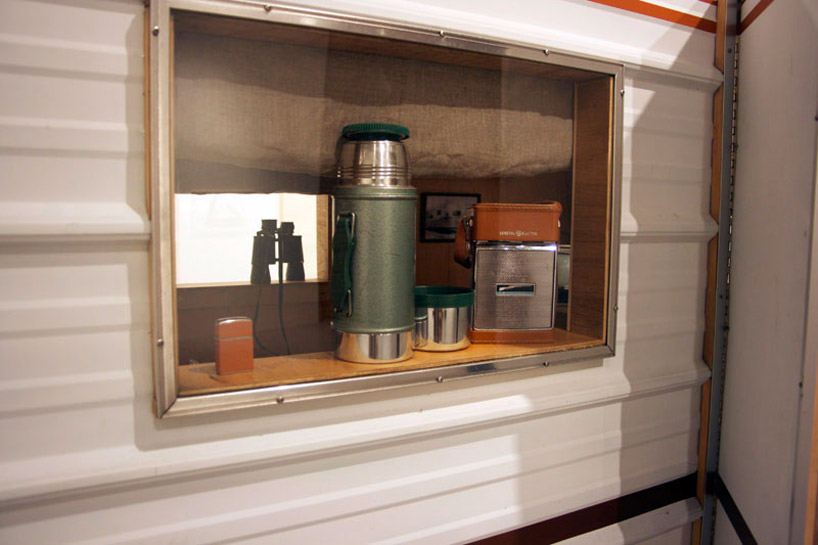 window detail 'little tag along' is a camper towed by an old raleigh 3-speed bike which could be considered the most 'romantic' of the installations. it expresses nostalgia for innocence and exploration, and is stocked with items reminiscent of childhood camping trips. 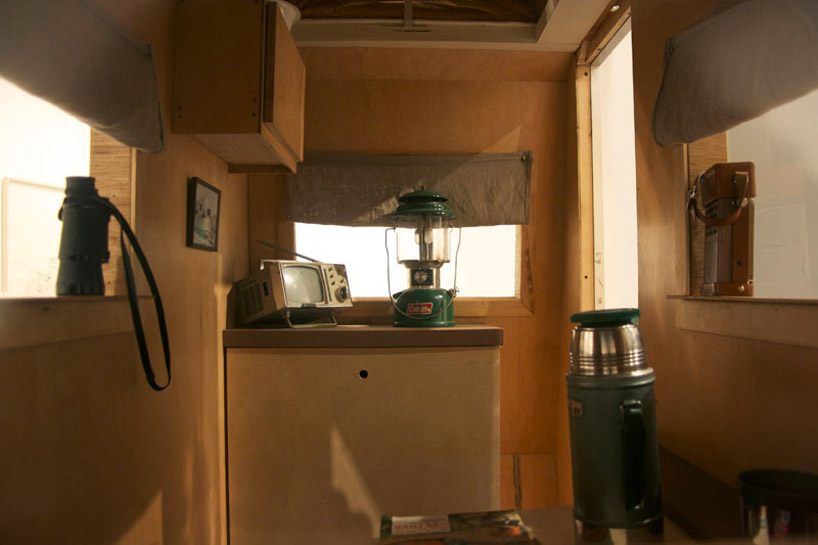 'little tag along' interior 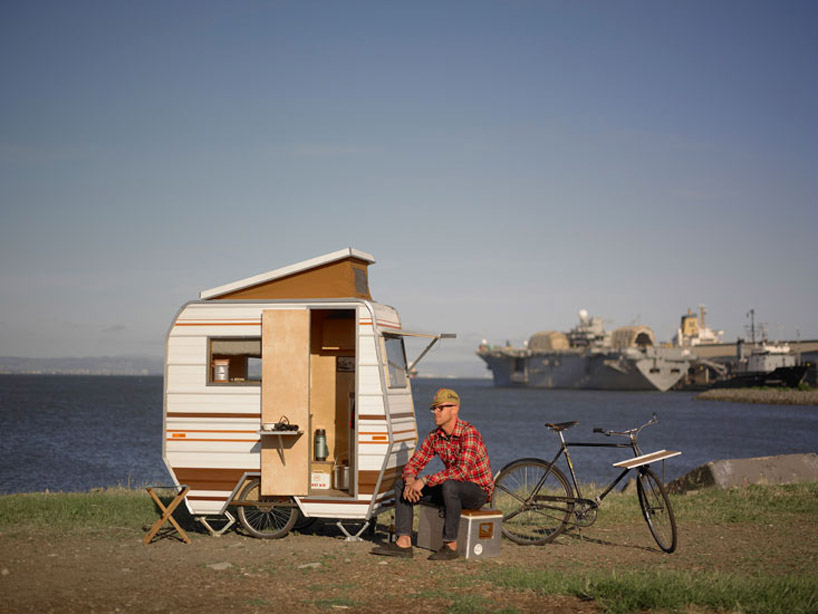 'little tag along' in use 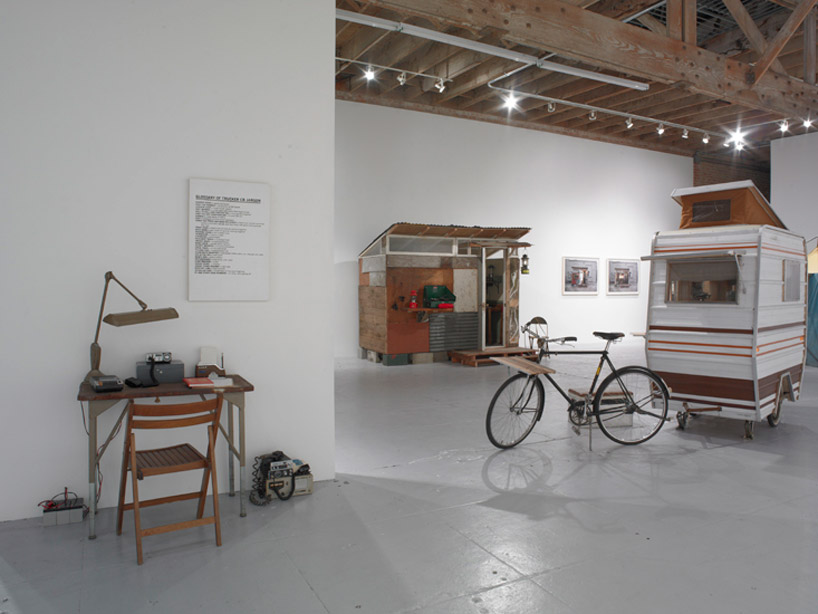 installation view of 'home in weeds' 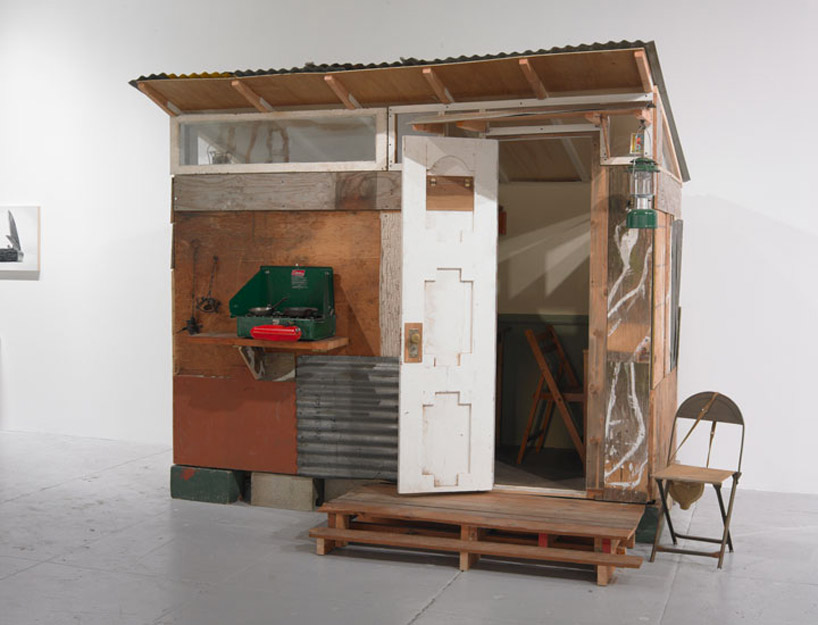 'shanty chateau' a stationary shelter constructed from discarded materials, 'shanty chateau' resembles an improvised dwelling from the outside and a comfortable abode upon entering. 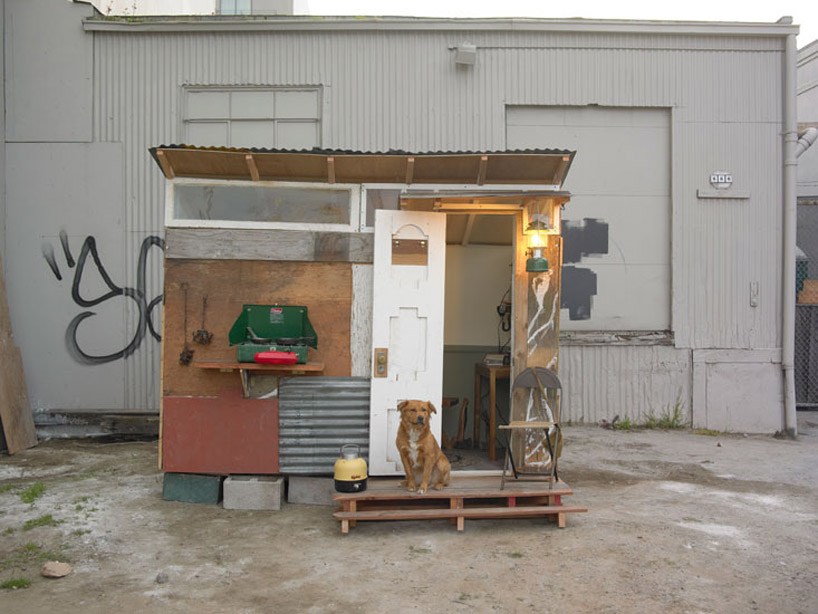 'shanty chateau' exterior 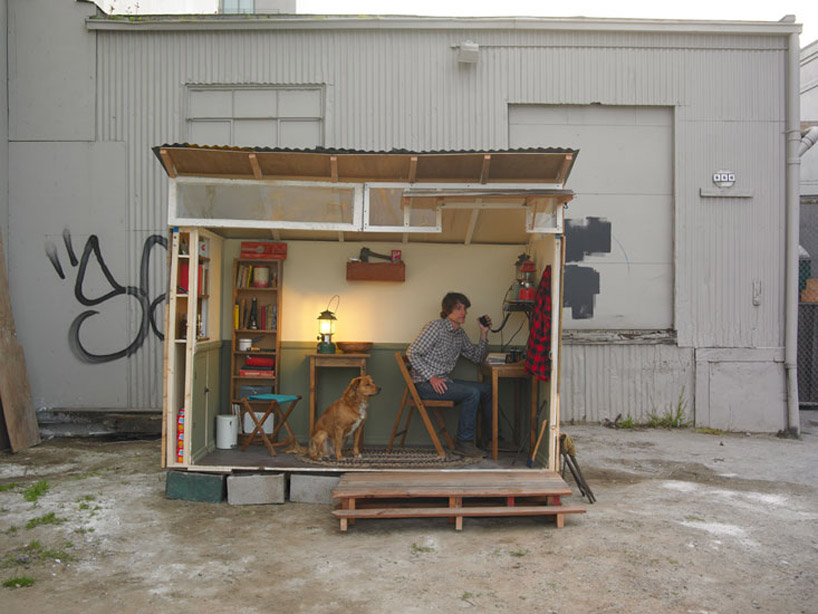 interior view of 'shanty chateau' 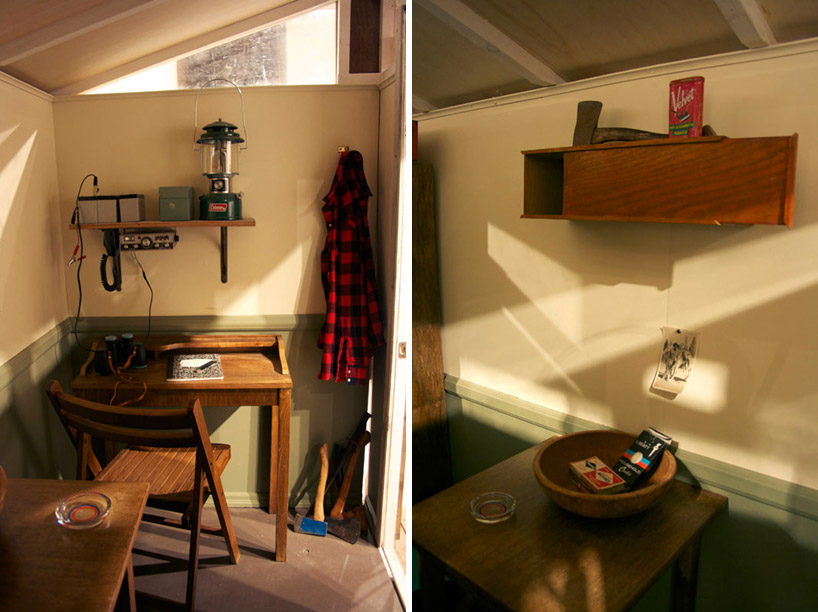 interior views 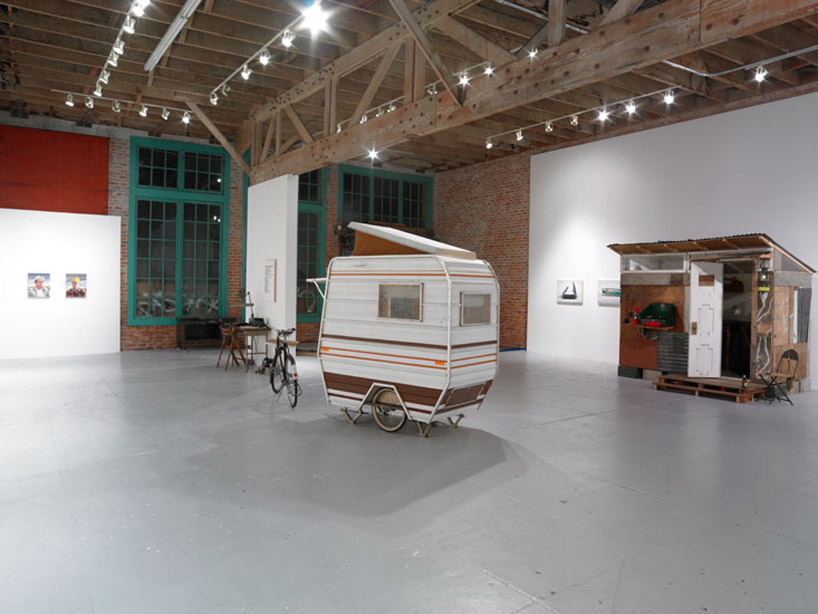 view of 'little tag along' and 'shanty chateau' at 941 geary 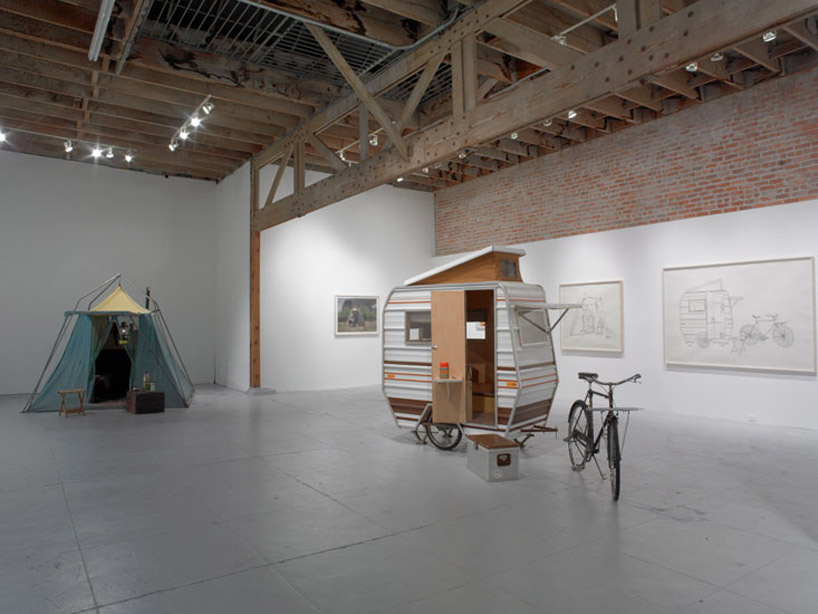 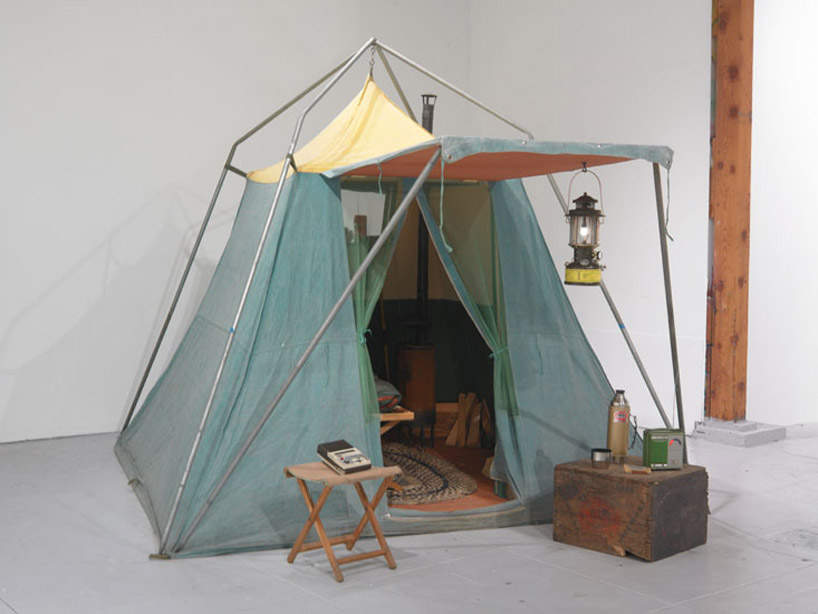 'cabin tent' with 'cabin tent' a vintage tent disguises a single room with wood floors, wainscoting walls and a wood burning stove.  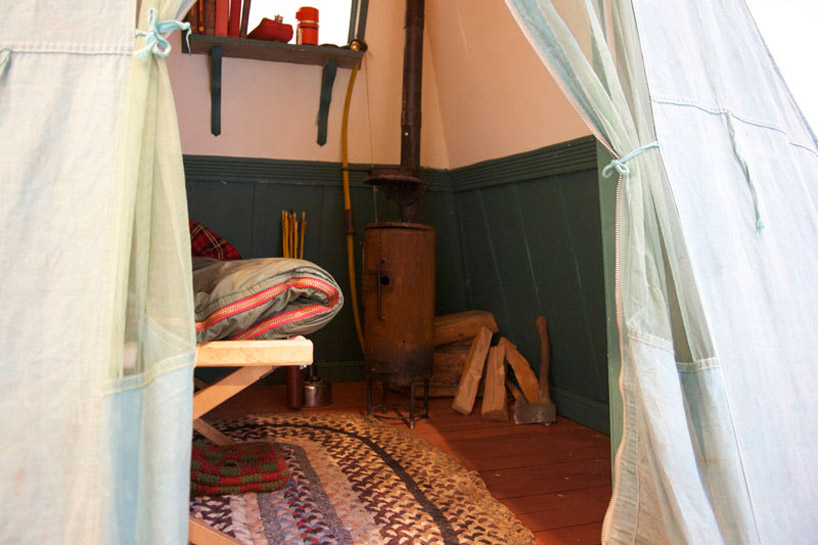 the furnished interior with wainscoting on the walls 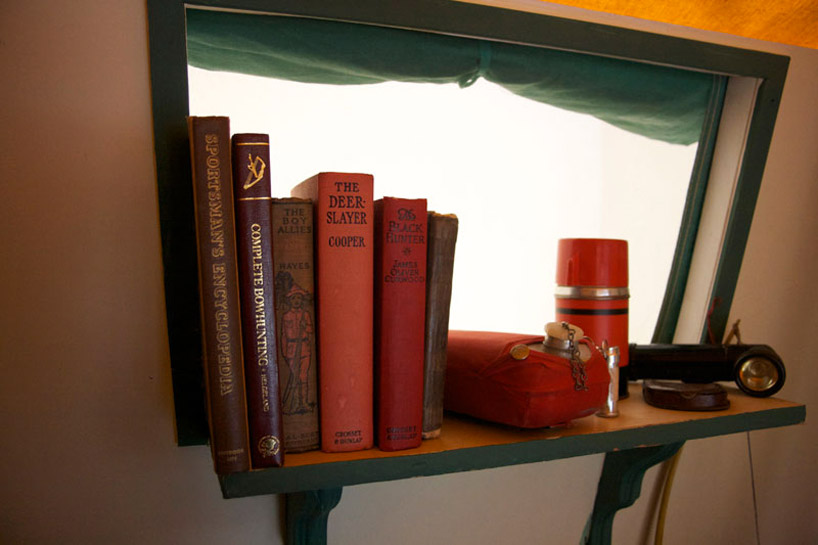 window sill details 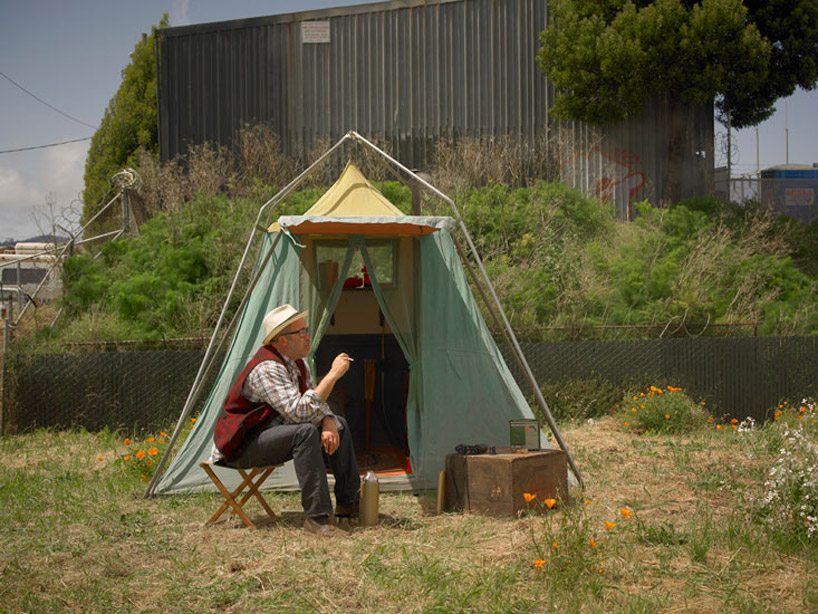 'cabin tent' in its element 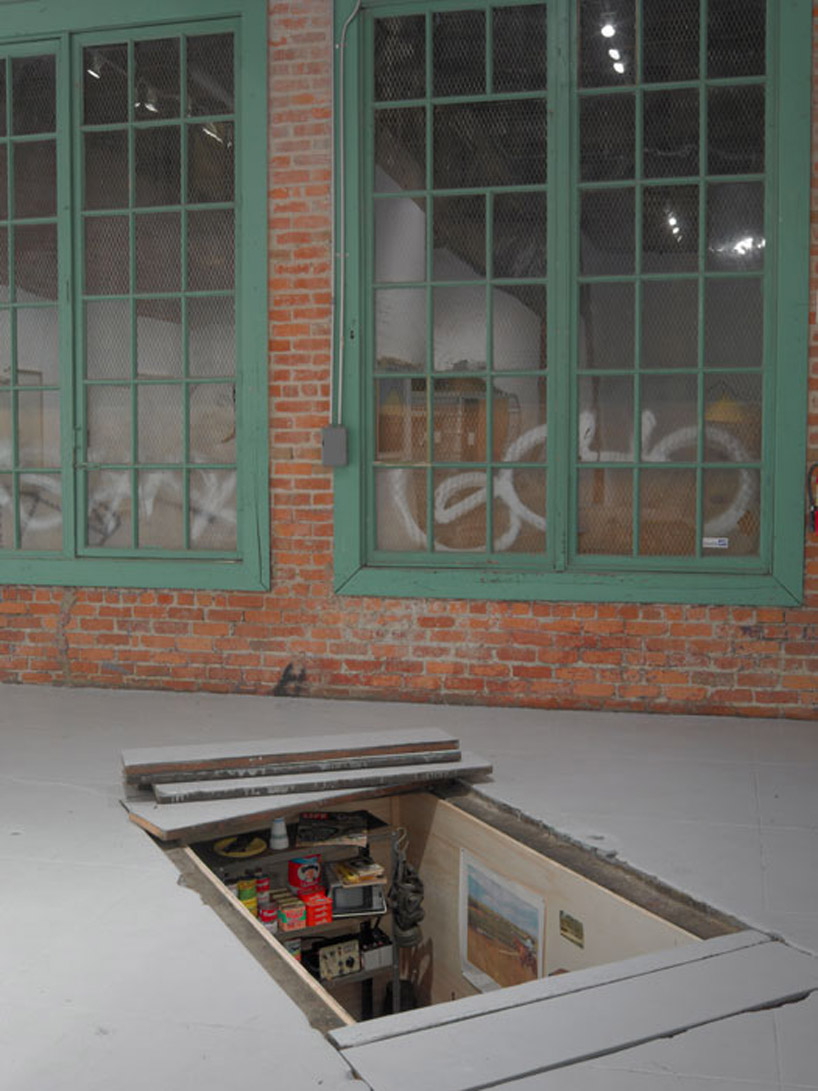 'fallout foxhole' a site-specific installation, 'fallout foxhole' is built into an old oil pit and resembles a fallout shelter. it is stocked with the barest of survival necessities and recalls the worse of doomsday prophesies.  a look into the 'fallout foxhole' 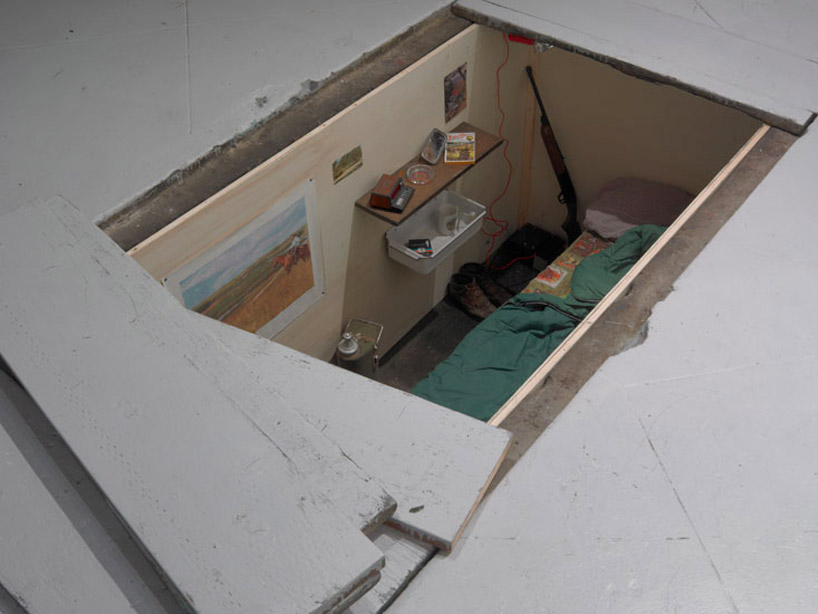 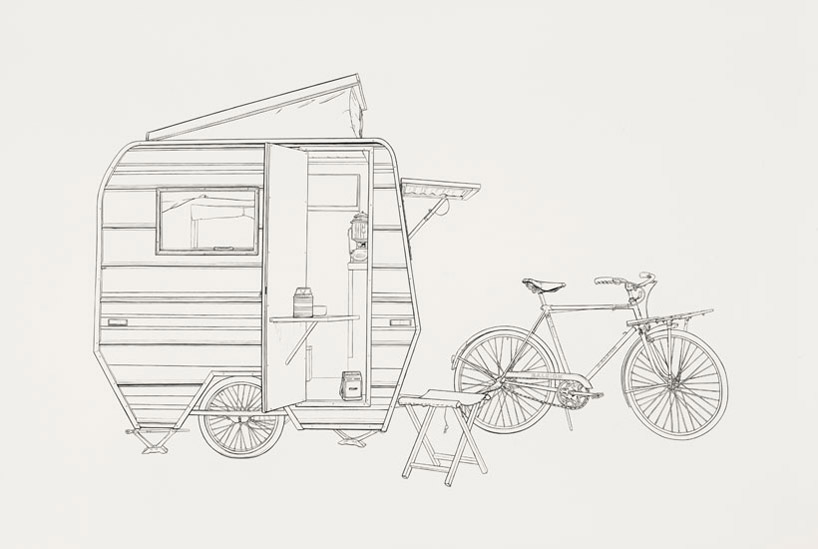 drawing of 'little tag along' paintings and photography are also displayed which explore the exhibition's overall themes, alongside diagrammatical drawings that emphasize the design of each piece. 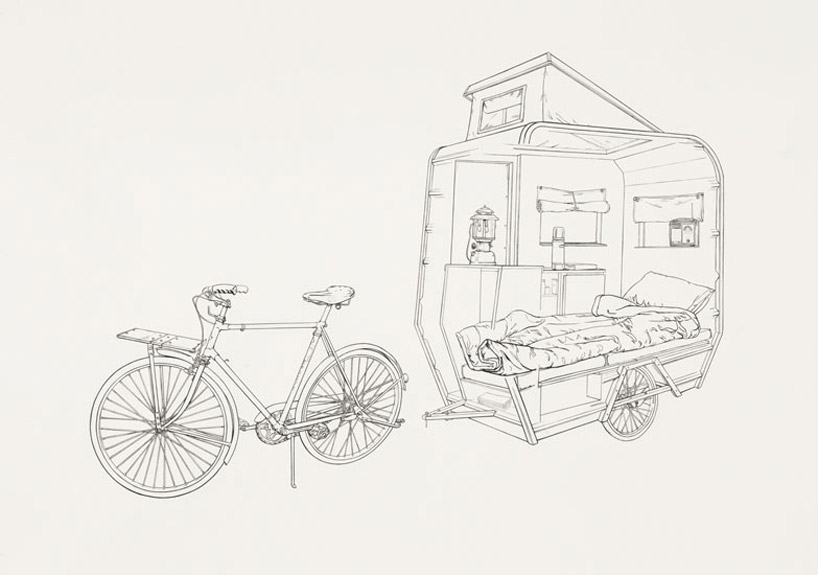 'little tag along' 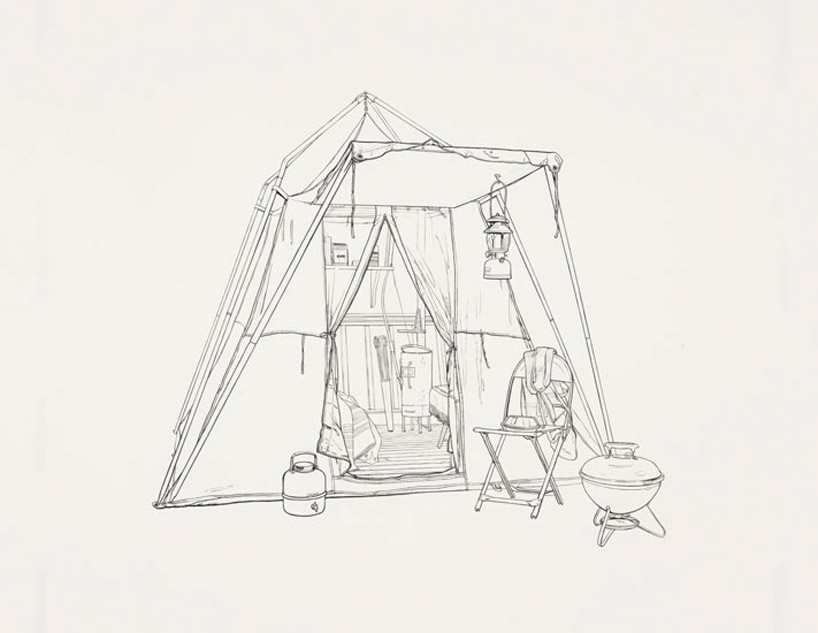 drawing of 'cabin tent' |
Art & Design by Kevin Cyr
Oprah as Muse: Five Unexpected Ways That the Talk Show Legend Impacted Art

Courtesy Getty Images
The final episode of Oprah's 25-year run aired on Tuesday.
By Julia Halperin
On the penultimate episode of Oprah Winfrey's beloved television show, aired today, actor Tom Hanks tells the TV icon in a video tribute: "Your show has turned surprise into an art form." Over the course of her 25-year-old show, Oprah — who will depart on May 25 to run her new cable network OWN full-time — has gifted cars to her entire studio audience, introduced stars to their biggest fans, and reunited Rwandan refugees. She likes surprising her celebrity guests, too: her no-holds-barred interview with James Frey contributed, in its own way, to establishing the author's rebel-artist persona.
But even Oprah's most avid followers may not know that while she herself is an artist of surprise, she is also the occasional muse for visual artists and a frequent patron of art institutions. In 2010, she served alongside Vogue's Anna Wintour as co-chair of the Metropolitan Museum's Costume Institute gala, while the stage door she donated to the Museum of Broadcast Communications in Chicago is currently on view through July 15. From her own deeply personal donation to a Wisconsin museum to a West Village gallery show memorializing her late dogs, Oprah's adventures with art are best described as eclectic. To honor Oprah's final show, ARTINFO has compiled a list of the top five moments in Oprah-inspired art, from the positively uplifting to the downright creepy.
1. "OPRAH WE LOVE YOU" COMMEMORATIVE PRINT
Art students at Lafayette University teamed up with visiting painter and feminist art great Faith Ringgold to create a limited-edition print in honor of Oprah's final show. The students at the school's Experimental Printmaking Institute worked with Ringgold to produce 25 silkscreen prints, a reference to Oprah's 25 years as talk show host. The exercise isn't quite as random as it sounds: Ringgold has been a guest on the show, and her work is represented in Oprah's personal art collection. The artist will present the prints — colorful, geometric renderings of the phrase "Oprah We Love You" — along with photos of the students, at the final taping.
2. AUSTRALIAN ARTISTS CLAMOR FOR OPRAH
When Oprah took her show to Australia for a week in December 2010, she certainly made her mark on the local art community. The Sydney Opera House was temporarily renamed the Sydney "Oprah" House in honor of her arrival, and her guests were granted access to the remote Aboriginal rock art formations in Australia's Northern Territory. But Oprah was also welcomed by a group of devoted local contemporary artists and artisans. For what appears to be no reason at all, a brick company spent four days and over 7,000 bricks building a wall emblazoned with a portrait of the talk show host. (The multicolor bricks create a close-up of Oprah, wearing gold earrings and some kind of brimmed hat; the Australian flag waves behind her.) Even creepier, Sydney body painter and make-up artist Eva Rinaldi started an international campaign to convince Oprah to pose for her in a bikini at various iconic Australian locations. "I have always wanted to body paint her," Rinaldi told an Australian newspaper. To promote her futile quest and presumably come as close as possible to living out her twisted and very unrealistic fantasy, Rinaldi ultimately found a Winfrey look-a-like and painted her as a lifeguard at Sydney's Bondi Beach.
3. "25 YEARS OF OPRAH" AT THE AFRICAN AMERICAN HISTORICAL SOCIETY
In honor of her final season, the New York African American Historical Society curated a retrospective of Oprah's career, compiling fan letters and props from her films alongside five original artworks by local artists. The exhibit, which opened in Harlem in October 2010, included such treasures as the original box LP album from "The Color Purple" as well as painter Cynthia Burgos's acrylic, black-and-while painting of Oprah as a child and Musa Keita's photo collage of Oprah and the many guests she's hosted on her talk show. "I wanted to represent Oprah from a Harlem prospective," Musa told the NY Daily News.
4. OPRAH'S ANGEL DONATION
In what may be the loveliest Oprah-and-art story, the television mogul donated 700 black angel figurines to the Angel Museum in Beloit, Wisconsin 10 years ago. Oprah's collection began accidentally: during an on-air interview with singer Cher in 1998, the host mentioned offhandedly that she loved angel statuettes but was unable to find Black ones. "I wonder if Black angels exist?" she asked. Her question inspired viewers to send Black angel figurines by the hundreds, until Oprah had to ask them to stop. (Awkward.) Once the flood began to subside, Oprah donated her collection to the small Wisconsin Angel Museum.
5. OPRAH PUPPY ART
What constitutes the all-time best Oprah-inspired artwork? Without question, weirdo sculptor Daniel Edwards's show "Memories of Sophie and Gracie: A Puppies' Memorial" at New York's Leo Kesting Gallery a few years ago (Edwards, of course, first came to fame with his sculpture of Britney Spears giving birth on a bear rug, seen at the gallery's previous incarnation, Capla Kesting Fine Arts, in 2006). Edwards also created an Egyptian-style gold Oprah sarcophagus, and a queenly Oprah burial mask as "a tribute to her inner beauty," but his most inspired Oprah work was a response to the TV host's announcement of the passing of her dogs. Her golden Labrador Gracie fatally choked on a ball in 2008, and her cocker spaniel Sophie died of liver failure only a few months later. "To represent Sophie and Gracie together, joined in Oprah's memory as they were in life and in Oprah's heart, the artist depicted them as conjoined at the hip and sharing a common tail," explained co-director John Leo of Edwards's sculpture. The golden sculpture depicts the dogs standing atop Oprah's head, a design, Leo explained, that suggests the extent to which the deaths may have been weighing on Oprah's mind. Yet the exhibition was not merely a memorial to pets lost — like so many episodes of Oprah's own show, it also aimed to teach viewers an important lesson: "Sophie's kidney failure may have resulted from natural causes, but we hope the Puppies' Memorial will remind everyone that Gracie's choking could have been prevented," Kesting said.
courtesy:artinfo1. "OPRAH WE LOVE YOU" COMMEMORATIVE PRINT
Art students at Lafayette University teamed up with visiting painter and feminist art great Faith Ringgold to create a limited-edition print in honor of Oprah's final show. The students at the school's Experimental Printmaking Institute worked with Ringgold to produce 25 silkscreen prints, a reference to Oprah's 25 years as talk show host. The exercise isn't quite as random as it sounds: Ringgold has been a guest on the show, and her work is represented in Oprah's personal art collection. The artist will present the prints — colorful, geometric renderings of the phrase "Oprah We Love You" — along with photos of the students, at the final taping.
2. AUSTRALIAN ARTISTS CLAMOR FOR OPRAH
When Oprah took her show to Australia for a week in December 2010, she certainly made her mark on the local art community. The Sydney Opera House was temporarily renamed the Sydney "Oprah" House in honor of her arrival, and her guests were granted access to the remote Aboriginal rock art formations in Australia's Northern Territory. But Oprah was also welcomed by a group of devoted local contemporary artists and artisans. For what appears to be no reason at all, a brick company spent four days and over 7,000 bricks building a wall emblazoned with a portrait of the talk show host. (The multicolor bricks create a close-up of Oprah, wearing gold earrings and some kind of brimmed hat; the Australian flag waves behind her.) Even creepier, Sydney body painter and make-up artist Eva Rinaldi started an international campaign to convince Oprah to pose for her in a bikini at various iconic Australian locations. "I have always wanted to body paint her," Rinaldi told an Australian newspaper. To promote her futile quest and presumably come as close as possible to living out her twisted and very unrealistic fantasy, Rinaldi ultimately found a Winfrey look-a-like and painted her as a lifeguard at Sydney's Bondi Beach.
3. "25 YEARS OF OPRAH" AT THE AFRICAN AMERICAN HISTORICAL SOCIETY
In honor of her final season, the New York African American Historical Society curated a retrospective of Oprah's career, compiling fan letters and props from her films alongside five original artworks by local artists. The exhibit, which opened in Harlem in October 2010, included such treasures as the original box LP album from "The Color Purple" as well as painter Cynthia Burgos's acrylic, black-and-while painting of Oprah as a child and Musa Keita's photo collage of Oprah and the many guests she's hosted on her talk show. "I wanted to represent Oprah from a Harlem prospective," Musa told the NY Daily News.
4. OPRAH'S ANGEL DONATION
In what may be the loveliest Oprah-and-art story, the television mogul donated 700 black angel figurines to the Angel Museum in Beloit, Wisconsin 10 years ago. Oprah's collection began accidentally: during an on-air interview with singer Cher in 1998, the host mentioned offhandedly that she loved angel statuettes but was unable to find Black ones. "I wonder if Black angels exist?" she asked. Her question inspired viewers to send Black angel figurines by the hundreds, until Oprah had to ask them to stop. (Awkward.) Once the flood began to subside, Oprah donated her collection to the small Wisconsin Angel Museum.
5. OPRAH PUPPY ART
What constitutes the all-time best Oprah-inspired artwork? Without question, weirdo sculptor Daniel Edwards's show "Memories of Sophie and Gracie: A Puppies' Memorial" at New York's Leo Kesting Gallery a few years ago (Edwards, of course, first came to fame with his sculpture of Britney Spears giving birth on a bear rug, seen at the gallery's previous incarnation, Capla Kesting Fine Arts, in 2006). Edwards also created an Egyptian-style gold Oprah sarcophagus, and a queenly Oprah burial mask as "a tribute to her inner beauty," but his most inspired Oprah work was a response to the TV host's announcement of the passing of her dogs. Her golden Labrador Gracie fatally choked on a ball in 2008, and her cocker spaniel Sophie died of liver failure only a few months later. "To represent Sophie and Gracie together, joined in Oprah's memory as they were in life and in Oprah's heart, the artist depicted them as conjoined at the hip and sharing a common tail," explained co-director John Leo of Edwards's sculpture. The golden sculpture depicts the dogs standing atop Oprah's head, a design, Leo explained, that suggests the extent to which the deaths may have been weighing on Oprah's mind. Yet the exhibition was not merely a memorial to pets lost — like so many episodes of Oprah's own show, it also aimed to teach viewers an important lesson: "Sophie's kidney failure may have resulted from natural causes, but we hope the Puppies' Memorial will remind everyone that Gracie's choking could have been prevented," Kesting said.
To see a video of Australia's brick-art tribute to Oprah, click on the video below:
Art Media & Techniques
Painting
Oil
Oil paint is a slow drying paint that is created by dispersing pigments in an oil, usually linseed oil. Oil paints are usually opaque, but can also be applied as a translucent glaze. Since the sixteenth century oil painting on canvas has been a standard medium for artists as it can be easily manipulated and has great flexibility, making it possible for an artist to achieve a layered or smooth, rich coloured canvas.Watercolour
Watercolours are translucent water-based paints. Based on a transparent or glaze system of pigmentation that utilizes the colour of the paper for its highlights.Acrylic
Developed in the middle of the twentieth century, acrylic paint is a type of synthetic resin based on polymer colours. The paint is made by dispersing pigment in an acrylic emulsion. The artist can thin these colours with water, but when dry the resin particles coalesce to form a tough, flexible, rubbery film that is impervious to water. This paint is popular because it dries quickly, enabling an artist to work over a painted area almost immediately. Although acrylics lack the manipulative qualities of oils and watercolours, artists can produce a matt, semi-matt or glossy finish by mixing them with the appropriate mediums.Gouache
Gouache is an opaque form of watercolour, and is different from transparent watercolour in that it has a definite, appreciable film thickness and creates an actual paint layer. It has a brilliant light-reflecting quality and is most popularly used in a high chromatic key or in strong contrasting values.Sculpture
Carving
Carving is a reductive or subtractive technique in which the artist removes the material through cutting or abrading a block of material to create a piece. Wood is very pliable and is therefore easy to carve, though subject to humidity and extreme temperatures as it breathes more than stone, and must be dried and cured prior to carving to prevent splitting or warping. Marble, the stone used most since antiquity, is very hard and difficult to carve; alabaster, which has a similar aesthetic property to marble, is soft and easy to carve; limestone, granite and sandstone are also popular media.Modeling
Modeling is the process in which a three-dimensional form is shaped from clay or wax. Clay works are then fired in a kiln to make the clay permanent and durable.Casting
A fluid substance such as plastic, clay or molten metal is poured into a cast (a mould which is made from a clay or wax model). Bronze (an alloy of copper and tin) is often used in casting, but concrete and resin can also be cast.Assemblage
The term refers to work such as welded metal constructions in which pre-formed elements are joined and was evident in the revolutionary art movements during the first quarter of the twentieth century in France, Russia and Germany.Printmaking
Lithography
Lithography consists of drawing or painting with greasy crayons and inks on limestone that has been ground down to a flat, smooth block. After several subsequent manipulations the stone is moistened with water, wetting the sections not covered by the crayon and leaving the areas of the greasy drawing dry as grease repels water. Oil-based ink is then applied with a roller and is repelled by the wet parts of the stone. The print made by pressing paper against the inked drawing is an autographic replica, in reverse, of the original drawing on stone.Monoprints and Monotypes
These two terms are often incorrectly assumed to be the same, but there are important differences. A Monoprint has a single underlying image (such as an etched plate or screen) that is made unique through a process of hand colouring or surface alteration to the printed image. A series of monoprints may be similar but are not identical. Monotypes are unique images and do not have a repeatable matrix (etched plate or screen). Instead, a thin even film of ink is rolled on to a plate which the artist then manipulates by drawing into it, or by rubbing sections off. The print image is taken directly from the plate.Intaglio Process Prints
Intaglio prints can be created through a number of processes, the common element is that the printed area isrecessed. These recessed areas are filled with a greasy printer's ink and then the surface is carefully wiped clean so that the ink remains only in the incised design. Types of intaglio include; Etching, Drypoint, Aquatint, Mezzotint, and Collagraphs.
Etching
The metal plate is coated with an acid-resisting wax or ‘ground’ that the artist draws into with a variety of tools, removing the ground from the areas that are to print black. The plate is immersed in an acid bath, which ‘bites out’ or etches the exposed areas. The etched plate is inked and the surface is wiped clean, leaving ink only in the etched depressions. Finally the plate is run through a press with dampened paper - the pressure forces the paperinto the etched areas of the plate, transferring the ink onto the paper. Rembrandt van Rijn first popularized this technique.
Drypoint
Artists working in drypoint draw the image directly onto the plate using a steel tipped ‘pencil’ that produces an added richness due to the burr (or shaving of metal that is turned up at the furrow). As the burrs are delicate and crush easily under the weight of the press, usually less than 50 impressions can be made.Aquatint
Aquatint is an etching technique which allows large areas of varying tones to be printed by means of a textured plate. The area to be etched is dusted with a powdered resin and then heated to melt it onto the surface. The plate is then placed in the acid bath to etch away the tiny areas not protected by the granulated resin.Mezzotint
This is perhaps the most labour intensive intaglio process and involves a plate being ‘rocked’ with a curved, notched blade until the surface is entirely and evenly pitted, creating a rough surface that prints black. Scraping the burr off or polishing the plate smooth creates half-tones and light. Colour mezzotints require a separate plate for each colour which will be printed consecutively.Collagraphs
Derived from the word 'collage,’ Collagraphs are created by building up an image on a plate surface (cardboard, metal, or plastic) with glue and other materials thereby creating recessed areas where the ink is retained.Relief Printing
This is the oldest printing technique and refers to the cutting away of part of the surface of a block of material so thatthe image area to be printed stands out in relief. Woodcuts or woodblock prints are made by cutting into the surface of a smooth piece of hardwood with a knife, and V and U gouges are used to create more delicate lines. When printed, the area that has been cut away remains white and the raised surface prints. A separate block is required for each colour. Printmakers rarely use more than three or four colours for aesthetic reasons. The linocut, a twentieth century adaptation, uses linoleum in place of wood and while it is easier to work with, it will not take very delicate or subtle cutting.
Screenprinting / Serigraphy / Silkscreen Printing
A twentieth century multicolour printmaking technique developed in America. The stencil process involves placing designs on a silk or nylon mesh screen that is attached to a wooden or metal frame, with the screen fabric at thebottom. Various film-forming materials, as well as hand-cut film stencils and photo-sensitive emulsions, are used as resists. Colour is poured into the frame which is placed in contact with the surface to be printed on. The colour is scraped over the stencil with a squeegee and deposited on the paper through the meshes of the uncoated areas of fabric.
Sugar Lift
Sugar Lift allows the artist to make a brush drawing directly on to the etching plate. After painting with a mix of sugar and ink, the whole plate is then covered with an acid resist. When dry, it is immersed in hot water, dissolving the sugar and exposing the brush drawing, which can now be etched. This is often used with aquatint to produce tone.Other Media
Pencil / Charcoal / Chalk
Ordinary lead pencils are made of graphite mixed with variable amounts of clay according to the degree of hardness required, with the softest varieties containing little or no clay. The paper texture must be coarse so that it ‘files’ down the pencil.Charcoal, due to its crumbly nature, can be used either for wispy strokes or shading, and is good for creating strong dark lines – the drawback with charcoal is that it smudges and tends to break easily.
Chalk is usually used for shading.
Pastel
Pastels are normally sold in three grades: soft, medium and hard. The soft is universally used, the other two mainly for special effects. The soft texture of pastels allows them to be easily manipulated. One of the charms of the finished drawing is its texture, as manipulations of the crayons produce a varied effect: thin or thick, smooth or rough, level or impasto.Ink
Ink has been used for many centuries in the Far East, and used to be sold in sticks that were rubbed with water in shallow mortars. Modern ink is sold in liquid form, either soluble or waterproof; the former is more suited to fine lines and delicate manipulations and effects, and coloured ink can be applied to wet paper to produce magnificent spreading effects.Collage
Collage became recognised as a serious art form in the early twentieth century. The term is derived from a nineteenth century craft called ‘papiers collés’ in which a variety of found objects including fabric, newspapers and cardboard are adhered to a flat surface to create a work of art.Digital Art
The term ‘Digital Art’ encompasses three categories:Digitally produced reproduction of an artwork already existing in another form, like a painting. Work produced to be viewed via digital means, which cannot be easily ‘owned’, such as web-art. Work produced digitally, or using a computer as a tool in the process, which results in a work existing outside of the computer – perhaps in the form of a lambda or giclee print, so that this digitally produced print can be considered to be an ‘original’. Work in this category may also exist in the form of a video, or more recently, a DVD. Such video’s and DVD’s will often be sold in limited editions, as with prints.
Photography
C-Type
Otherwise known as a Chromogenic Colour or Colour Coupler print, C-Type is the generic name for a modern colour print. Colour sensitive layers of emulsion on the paper respond to the colour information in the negative when light is shone through it. After the initial development, chemical compounds called dye couplers are added to form a layer of hues that produce the full colour image.Digital C-Type / Lambda / Lightjet
The Lambda, or Lightjet, is a C-type printed from a digital image file (captured digitally or scanned from a print or film). The image is projected onto light sensitive paper using sophisticated laser technology.Editions
An edition is a predetermined number of prints at a specific size from a single image. An edition print should be of exhibition quality and will be individually numbered (e.g. 5/10), signed and dated, either on the print itself or on an accompanying certificate. Often an ‘Artist Proof’ will exist separate to the edition and is usually the first or last to be printed. Editioning is more common among contemporary photographers and gives the collector an assuranceof authenticity.
Gelatin Silver Print
Known as the most common form of black and white printing. Photosensitive particles called silver halides are suspended in a thin layer of gelatin on paper. When the paper is exposed and processed, the particles react and change according to the concentration and brilliance of the light.Inkjet or Giclée Print
Inkjet prints, also know as Giclée prints, are produced from a digital image file by a computer driven printer thatsprays minute droplets of ink onto paper. The term ‘inkjet’ covers everything from cheap throwaway prints to exquisite works printed on fine paper. The development of stable, archival inks and dedicated papers is ensuring the popularity of these prints.
Iris Print
Similar to an inkjet but produced on a machine that spins the paper on a drum. This process uses similar inks to inkjets and is sometimes referred to as a Giclée print.Lith Print
Different to lithographic printing, a Lith print is made by over-exposing the print and then under-developing it using powerful Lith chemistry. Usually printed from black and white negatives, Lith prints are typically grainy and contrasty, with dark shadows and soft highlights, and can take on different hues depending on the paper and age of the chemistry used.Platinum Print
A form of black and white printing that uses platinum instead of silver salts. Platinum is reduced from light sensitive iron salts to form an image as platinum particles become embedded in the paper. Known for their wide range of subtle tonal variations and fine grain, platinum prints have a significantly longer life expectancy than silver prints. Palladium is often used as an alternative to platinum, giving similar results.Polaroid
Polaroid is film that develops moments after exposure giving an instant positive or negative print that is completely unique. Polaroid has many creative possibilities. Artists experiment with emulsion lifts and image transfer. Emulsions lifts involve soaking the Polaroid in hot water and separating the emulsion from the photographicpaper. The emulsion can then be shaped or stretched onto a new piece of paper and worked into using paint and other media. Image transfer is where the Polaroid is prematurely peeled and then placed against a new receptor paper to develop normally.
R-Type
A colour print made by the reversal process from a positive film (transparency or slide), you can also print from positive film using Ilfochrome, which incorporates a dye-bleach process, resulting in purer and more permanent colour.Modern Print
A print produced a significant amount of time after the photograph was taken. For example a 1950’s print reprinted in 2000.Vintage Print
A print produced within 5 years of the making of the negative. Valuable to collectors as it is thought to demonstrate the photographer’s initial intention, the print will perhaps reflect process-based trends from the time when the photograph was taken. A vintage print may not be the best quality of print available of the desired image, but is sought after due to its telling properties.courtesy AAF
Subscribe to:
Posts (Atom)


